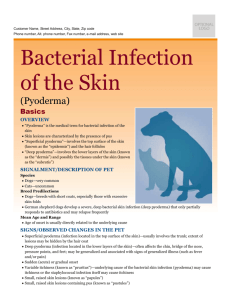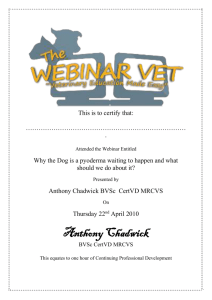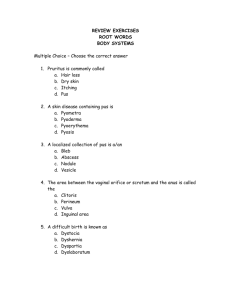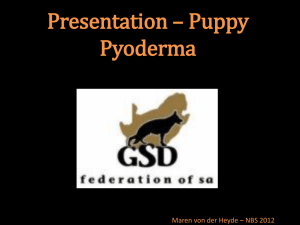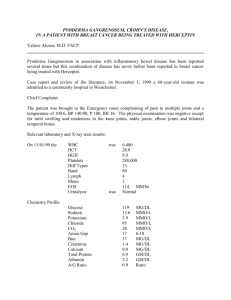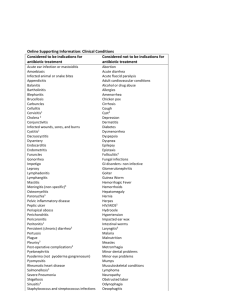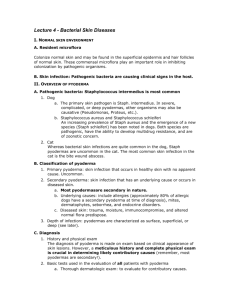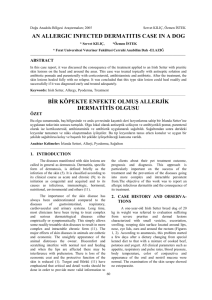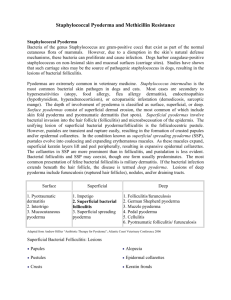Press Release
advertisement
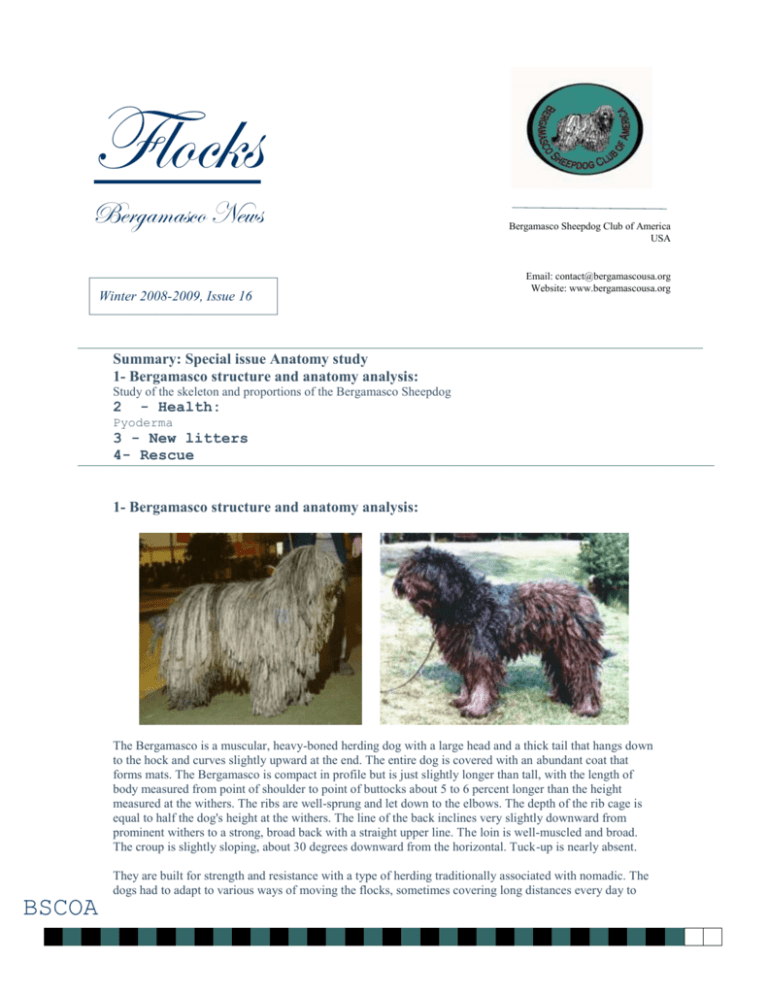
Flocks Bergamasco News Winter 2008-2009, Issue 16 Bergamasco Sheepdog Club of America USA Email: contact@bergamascousa.org Website: www.bergamascousa.org Summary: Special issue Anatomy study 1- Bergamasco structure and anatomy analysis: Study of the skeleton and proportions of the Bergamasco Sheepdog 2 - Health: Pyoderma 3 - New litters 4- Rescue 1- Bergamasco structure and anatomy analysis: The Bergamasco is a muscular, heavy-boned herding dog with a large head and a thick tail that hangs down to the hock and curves slightly upward at the end. The entire dog is covered with an abundant coat that forms mats. The Bergamasco is compact in profile but is just slightly longer than tall, with the length of body measured from point of shoulder to point of buttocks about 5 to 6 percent longer than the height measured at the withers. The ribs are well-sprung and let down to the elbows. The depth of the rib cage is equal to half the dog's height at the withers. The line of the back inclines very slightly downward from prominent withers to a strong, broad back with a straight upper line. The loin is well-muscled and broad. The croup is slightly sloping, about 30 degrees downward from the horizontal. Tuck-up is nearly absent. BSCOA They are built for strength and resistance with a type of herding traditionally associated with nomadic. The dogs had to adapt to various ways of moving the flocks, sometimes covering long distances every day to get to the grazing grounds, while at other times they would only cover short distances within specific areas. - Sheeps are timid in nature and tend to bolt when scared, the dogs job is to keep the upper hand without provoking panic. - When the flocks moves, it is slowly with a tendency to disperse, the dogs had to walk along side the flock, moving back and forth with no specific need for great speed. On the contrary, the gait has to be slow and even requiring great resistance. - When the grazing area are reach, the dogs had to keep an eye on the flock, seethe the sheeps did not wander too far or run into danger by getting to close to ravines and cliffs. When intervention is indispensable, the dogs needed to avoid brusque movements to avoid the sheeps to panic with a full stomach. The best suitable gait for the Bergamascos to achieve a calm and balance movement while preserving energy is the trot, a flowing ad regular gait which can be maintained over long period of times without exhausting the dogs. A very important structural characteristic, affecting the Bergamasco Sheepdog locomotion for optimum efficiency while performing their tasks, is the importance of the length of the body. Many dog fanciers would like the dog to be square, meaning that the body length to be equal to the height at the withers. In trotters, it is mechanically necessary for the body to be longer than the height at the withers. A typical galloper (i/e Pointer) would have an equal proportion of the lumbar tract (1/5 of the height at the withers). If the square dog’s (galloper) proportions were to be applied to a trotter, the body would be squeezed into unnatural proportions and a shortening of the croup. This would create an insufficient length of fallaway and, in consequence, hind limbs which are too straight and a tail inserted too high up. To fit into a square two body parts can be shorter: - if the lumbar region, it would not be an advantage to a trotter, provided that the gait remains flowing. - if the croup with insufficient fallaway, it would be a serious fault because it would alter the entire build of the dog. Dog built with either shortening could never develop a flowing gait. Their paws would hit the ground hard and they would take short steps with rigid limbs, covering very little ground. In addition, when trotting, the front paws would start lifting from the ground when already passed the middle of the body, so that the back paws would bump into the front ones when lifted. To avoid this, the dog would either have to alter the setdown rhythm, and forfeiting the typical synchronism of the trot, or loose the possibility of utilizing the rear hand drive which would shorten the step. None of which would be suitable for a long day of work. It is essential for the loin to be sufficiently long so as not to encumber the advance of the rear limbs and alter the rhythm sequence of support and suspension. In the case of wild trotting canids, such as wolfs, coyotes and jackals for which efficient locomotion is an essential factor for survivor, the body length is 10-20% above their height at the withers. The Bergamascos who always carried out its work in mountainous regions needs a solid and compact build. The loin is the suspended track of the spine, if excessively long; it would not be suitable for rapid ascent and for downhill leaping required for Alpine dogs, while less pernicious for sheepdog breeds which work in plains. In order to be most efficient in its environment which requires work on steep hill, the Bergamasco is best built with a difference of 5-6% between the two measurements (body length and height at the withers) without making the dog any less compact. Below are 2 diagrams analyzing the proportions and angulations of the Bergamasco Sheepdogs: * Height at the withers: 60 cm +/- 2 cm for males 56 cm +/- 2 cm for bitches * Body length: 5-6'% above the height at the withers = 63 cm * Distance from withers to elbow = distance from elbow to ground * Croup (pelvis): 31-32'% of the height at withers = 18-19 cm * Neck: longer than head =19-20 cm * Shoulder blade: more than 1/4 of height at withers = 16~17 cm * Humerus: same length or slightly longer than shoulder blade = 19 cm * Radius: same length or slightly longer than humreus = 19-20 cm * Metacarpus: short, distance from ground = 10 cm. * Femur: 10% longer than coxal = 20-21 cm * Tibia: same or slightly longer than femur'" 20-22 m * Hock: from hock to ground 25% of height at withers' =15 cm Limb articulations of the Bergamasco Sheepdog: * Shoulder blade: 55°-60° from horizontal * Humerus: 60 from horizontal * Angle between humerus & shoulder blade: 115°-120° * Angle of metacarpal from vertical: 10° * Pelvis fallway from horizontal: 35°-40° * Coxo-femoral angle: 95°-100° * Tibia: 40°-45° from horizontal * Femuro-tarsal angle: 105°-110° * Tibio-tarsa angle: 130°-135° Below Two diagrams comparing the Bergamasco structure tow the Briard, the Bearded collie, the Komondor and the Puli 2- Health : Pyoderma Clinical Aspects, Diagnosis and Therapy of CANINE PYODERMA INTRODUCTION There are a large number of bacterial diseases of the skin in dogs, with different histopathological and clinical aspects. Some are superficial and benign (the basement membrane is not destroyed by the infectious process) and some are deep and severe (the basement membrane is destroyed). Pseudopyodermas are not real pyodermas since infection plays only a secondary role and anti-infectious therapy is not effective. Staphylococcus intermedius is the most common infectious agent cultured in canine pyoderma. It can multiply easily in the dog's skin, due to the thinness of the stratum corneum and the lack of sebum plug in the hair follicles. Inflammation of the skin, particularly due to allergy, is the most common cause of pyoderma, more than real immunodeficiency. SUPERFICIAL PYODERMA 1. Skin fold pyoderma (intertrigo) These lesions are seen in anatomical defects where there is an important bacterial colonization: lip, facial, vulvar, caudal, obese and mammary folds. The dermatosis is localized with erythema, exudation, suppuration and bad odour. 2. Impetigo In juvenile impetigo, subcorneal pustules are present on the ventral side of the body, with crusting. The disease is self-limited. In adult impetigo, large pustules ("bullae") are seen all over the body. In general, adult impetigo is severe and secondary to an underlying disease (hyperadrenocorticism, glucocorticoid therapy...) or multiple traumas (e.g., during hunting). 3. Folliculitis Juvenile folliculitis: numerous follicular pustules are present on the ventral side of the body. The condition often heals at puberty. Short-haired dog pyoderma: there are generalized follicular pustules, epidermal collarettes and crusts, with a "moth-eaten" hair. Pruritus disappears when the lesion heal. Secondary folliculitis: this common disease is characterized by follicular pustules, epidermal collarettes and crusts which are often generalized. Pruritus is still present after lesions healing in case of underlying pruritic dermatosis. The disease may also generate pruritus in a usually nonpruritic dermatosis (in such cases pruritus disappears when lesions heal). Juvenile folliculitis: numerous follicular pustules are present on the ventral side of the body. The condition often heals at puberty. Short-haired dog pyoderma: there are generalized follicular pustules, epidermal collarettes and crusts, with a "moth-eaten" hair. Pruritus disappears when the lesion heal. Secondary folliculitis: this common disease is characterized by follicular pustules, epidermal collarettes and crusts which are often generalized. Pruritus is still present after lesions healing in case of underlying pruritic dermatosis. The disease may also generate pruritus in a usually nonpruritic dermatosis (in such cases pruritus disappears when lesions heal). "Bacterial hypersensitivity" and/or superficial spreading pyoderma: bacterial hypersensitivity is an uncommon disease based on a clinical triad: erythematous follicular pustules, target lesions/seborrhoeic plaques, haemorrhagic bullae. There is sometimes a severe pruritus. The existence of a real bacterial allergy is presumed and debatable. In superficial spreading pyoderma, nummular areas of alopecia and erythema are centrifugally expanding, with epidermal collarettes and crusts. These lesions are often associated to intact but transient follicular pustules. Deep folliculitis: it is the so-called acral lick dermatitis, most often a deep follicular bacterial infection with retrograde hidrosadenitis secondary to a psychogenic and/or an allergic cause. Pyotraumatic folliculitis: some cases of folliculitis (e.g., in Labradors, Retrievers) appear as oozing suppurative plaque with pain. They are surrounded by satellite pustules of folliculitis or even furunculosis, which help to differentiate them from the "classical" pyotraumatic dermatitis. D E E P P Y O D E R M A 1 Furunculosis Acne: papulo-pustules and pustules are seen on the face, particularly the chin, in young dogs. Secondary furunculosis: localized or generalized pustules are associated or secondary to a folliculitis and the disease is triggered or aggravated by an excessive therapy (e.g., glucocorticosteroids). Nasal pyoderma: pustules and crusts are present on the bridge of the nose and eyelids. There may be an unpleasant scaring. This true bacterial nasal pyoderma of unknown cause should be differentiated from the sterile eosinophilic furunculosis possibly due to arthropod bites. 2. Cellulitis A. Localized cellulitis Pressure points pyoderma: there are necrotizing lesions of the elbows, the rump, the stifles, the hocks and the lateral digits. They are due to permanent trauma in heavy dogs. Various localized cellulites: These are other localized necrotizing lesions (e.g., perianal). Their cause is often unknown; they are sometimes secondary to a furunculosis. B. Generalized cellulitis Pyodemodicosis: There is an extensive necrotizing skin disease, which is secondary to a generalized demodicosis (an immunodeficiency status). Various generalized cellulites: necrotizing lesions are extensive and often secondary to other immunodeficiencies. 3. The interdigital pyoderma complex There are very numerous causes of non infectious pododermatitis with erythema, oedema, oozing and alopecia. The same lesions are present in interdigital pyoderma along with furunculosis, ulcerations, fistulae and necrosis (cellulitis). Interdigital pyoderma is often secondary. PSEUDO-PYODERMA 1. Pyotraumatic dermatitis The typical lesions have an acute onset and are characterized by alopecia, erythema, oozing, suppuration, pruritus and/or pain. These lesions are common, and most often associated to pruritic skin disease. They are poorly understood (sometimes due to vasculitis?). There is a spontaneous healing in a few days, but a short treatment is useful. 2. Juvenile pyodermas Juvenile pyoderma of new-born puppies: crusty lesions are present on the face, thorax and dorso-lumbar area. They might be due to trauma. No treatment is required since there is a spontaneous healing. Juvenile cellulitis: The aetiology of this disease is unknown. The typical clinical aspect is a facial oedema and furunculosis, with fistulae, crusting and a suppurative otitis externa. Adenopathy and sterile abscesses (cellulitis) are present. The onset of this uncommon disease occurs before 4 months of age in one or several puppies of a litter. There is a spontaneous healing in a few weeks with scaring but treatment is required. D I A G N O S I S O F C A N I N E P Y O D E R M A Diagnosis of canine pyoderma is based on history, physical examination and complementary examinations: cytology, histopathology and bacteriology. 1. Cytology In intertrigo (skin fold pyoderma), images of "bacterial colonization" are observed, i.e., healthy neutrophils, Cocci and Bacilli in an extracellular position and degenerated neutrophils in a state of phagocytosis. In impetigo and folliculitis, impaired (degenerated) neutrophils are only found. The pictures of Cocci phagocytosis are not particularly numerous. This is an image of "bacterial invasion", i.e., the penetration of pathogenic germs into the skin. The significance of the pictures of phagocytosis differs considerably depending on whether they are observed on the surface or in a cutaneous lesion. In effect, when they are observed inside the skin (epidermis, hair follicles, dermis) one might consider that the phagocytosed germs are pathogenic and that there is a real bacterial pustulosis. In contrast, phagocytosis observed on the surface indicates multiplication of germs which are not necessarily and probably rarely pathogenic. In deep pyoderma cytology is less likely to reveal the germs and pictures of phagocytosis, although they must be looked for. Frequently there are a granulomatous reaction, eosinophils and red blood cells. Bacterial colonization is observed in pyotraumatic dermatitis as in intertrigo but it is not significant and treatment with antibiotic does not result in remission. In juvenile cellulitis, the degenerated neutrophils are very numerous, with a granulomatous reaction. No germs are seen. 2. Histopathology This will show typical lesions, but is relatively rarely performed for the diagnosis of canine pyoderma, except in case of difficult differential diagnosis. 3. Bacteriology This can confirm the bacterial infection and allows sensitivity testing. T R E A T M E N T O F C A N I N E P Y O D E R M A Systemic (antibiotic) and topical therapy can be used in canine pyoderma. 1. Selection of antibiotics The criteria for the choice of an antibiotic are as follows: appropriate kinetics and good cutaneous penetration, activity against Staphylococci, activity in pus and reactive tissues, bactericidal activity rather than bacteriostatic activity particularly in severe cases, easy administration (oral, q12h or q24h), absence of secondary effects, reasonable cost. The choice can be empirical, particularly in superficial pyoderma, after cytological examination of pus from an intact pustule which shows bacterial invasion. Bacteriology and sensitivity testing must be used in case of deep pyoderma, recurrent pyoderma, when cytology shows a complex flora with rods, and in case of empirical antibiotic therapy failure. They can be repeated during therapy. 2. Dosage and duration of treatment Ideal doses must be used and duration of treatment must be long enough (a few weeks to several months depending of extension and depth of lesions, and always beyond clinical cure). Maintenance pulse treatment (e.g., 2 to 3 days a week) can be used in chronically relapsing pyoderma but it could theoretically select resistant strains as well as the use of subminimal doses. They are both used for economical reasons but the former is preferable. 3. Antibiotics useable in canine pyoderma Antibiotics useful in canine pyoderma are included in the following table. They all have a good cutaneous diffusion (because of their liposolubility) and can be given orally, which is useful because of long therapeutic courses (ease of administration). They are all bactericidal except macrolides which are bacteriostatic. Penicillin G (which is injectable) and A are sensitive to penicillinases. Aminoglycosides have a low cutaneous diffusion (they are hydrosoluble), are injectable and toxic. Chloramphenicol has a bad reputation in humans and the cat (haematologic toxicity). Tetracyclines have a very low activity against Staphylococci. These antibiotics are never or rarely used in canine pyoderma. Rifampicin is effective against Staphylococci but, as it is still used to treat human tuberculosis, it should be used when there is no other possibility (5 to 10 mg/kg SID). In addition, it should be then associated to a betalactamine to prevent the selection of resistant strains of Staphylococci. Mupirocine, a topically active bactericidal antibiotic, in a polyethylene glycol base is effective against Gram+ Cocci, is not systematically absorbed and is not chemically related to other antibiotics. It can be used in localized pyodermas (acne, pressure point pyoderma, interdigital pyoderma). 4. Associated treatments Topical therapy is always beneficial in canine pyoderma, particularly in superficial staphylococcal disease. Clipping can be useful and is necessary in deep pyoderma such as cellulitis. The main useful topical products are chlorhexidine (lotion and/or shampoo), povidone-iodine (lotion and/or shampoo), benzoyl-peroxide (shampoo and eventually gel), ethyl-lactate (shampoo). They should be used frequently, e.g., once a day, at the beginning of therapy. Later, frequency of application may decrease. Each shampoo should be followed by the application of an appropriate humectant. Topical or systemic glucocorticoids should never be used in true canine pyoderma, even in case of pruritus, because they cause severe relapses ("rebound effect"). In contrast they can be used and are effective in pseudo-pyoderma (e.g., oral prednisolone: 1 mg/kg/day for pyotraumatic dermatitis and 2 mg/kg/day for juvenile cellulitis). C O N C L U S I O N Canine pyoderma is a group of various skin diseases and an accurate diagnosis is mandatory. An appropriate antibacterial therapy is required in most cases of canine pyoderma, in association with topical therapy. Antibiotics must be selected carefully and used with appropriate dosage and duration of treatment. D.N. Carlotti, DECVD Cabinet de Dermatologie Vétérinaire Bordeaux-Mérignac, France 3 - New litters Ch Niso Dell Albera Silver blue and Ch Nyx Dell Albera from Artos Bergamascos 8 puppies: 4 girls 4 boys Litter Born December 21th 2008 Silver Night Clothos and Karhmae from SilverPastori 6 Puppies: 6 boys Litter Born November 10thst 2008 4- Rescue: Smiley Thanks to its network, the rescue department of the Bergamasco Sheepdog Club of America found Smiley in a kill shelter in Missouri. Smiley’s story has been posted in the Bergasmasco form on line and within hours Smiley had several homes ready for her. After a little investigation, we found out that Smiley was actually a Komondor and not a Bergamasco. While the Bergamasco folks were still offering smiley a home, the rescue club contacted Joy Levy at MASKC (Mid Atlantic Komondor Club). They put us in touch with Ruth Keller from their rescue department, and together we worked at finding a home for Smiley. After a few days of coordinated work, Smileys future was bright. Here is Ruth’s latetst update on Jan 17th: “I have good news. Smiley is going to be picked up from the Pound tomorrow at noon and she will arrive in NY state on the 19th around mid-day. I got a very nice couple through U-Ship. I put in a request for transport and received bids. I can’t recommend it enough for people needing to transport dogs. Smiley will ride in the back seat of their jeep. Smiley is going to a friend, Bunny who helps me with rescue, and her vet will give her vaccines, de-worm, check heartworm, etc. She will be there for two weeks in foster care as a house dog. A very good friend of Bunny’s, Deanna, who lives in Indiana and is currently in S. America will return to NY. They will drive together back to her place in Indiana. Deanna breeds a rare type of goats and has had Komondors in the past. She lost her oldest one at 13, and the 9 year old needs a companion. Her dogs are very well cared for and are inside at night. I know it will be a wonderful home. All of the policemen I have spoken with at the Rolla Animal Control center have raved about what a wonderful dog she is. Thank you and the Bergamasco people so very much for saving this dog’s life. We are all very grateful to you. Ruth Keller M.A.S.K.C. Rescue Chair” BSCOA

